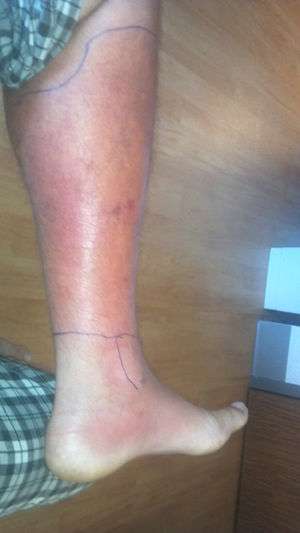Cellulitis
Background
- Acute spreading infection of the dermis and subcutanous tissue, causing overlying skin inflammation[1]
- Most often caused by streptococcus or staphylococcus (including MRSA)
Risk factors[2]
- Previous cellulitis
- Wound or current leg ulcers
- Excoriating skin diseases
- Lymphedema
- Venous insufficiency
- Obesity
- Tinea pedis
Clinical Features

Cellulitis of the leg
- Rash
- Local erythema, warmth, swelling
- Tender indistinct margins
- Can be accompanied by fever, chills, malaise, headache, nausea/vomiting
Differential Diagnosis
Skin and Soft Tissue Infection
- Cellulitis
- Erysipelas
- Lymphangitis
- Folliculitis
- Abscess
- Necrotizing soft tissue infections
- Mycobacterium marinum
Foot infection
- Cellulitis
- Gangrene
- Trench foot
- Abscess
- Necrotizing soft tissue infections
- Osteomyelitis
- Diabetic foot infection
- Wet-sock erosions
Erythematous rash
- Positive Nikolsky’s sign
- Febrile
- Staphylococcal scalded skin syndrome (children)
- Toxic epidermal necrolysis/SJS (adults)
- Afebrile
- Febrile
- Negative Nikolsky’s sign
Evaluation
- Generally clinical diagnosis, may be assisted by ultrasound (above)
- Ultrasound can aid in diagnosis - may see "cobblestoning" of subcutaneous fat due to accumulation of fluid in these tissues. Also helpful to evaluate for abscess.
Management
Outpatient
Coverage primarily for Strep
MRSA coverage only necessary if cellulitis associated with: purulence, penetrating trauma, known MRSA colonization, IV drug use, or SIRS[4]
- 5 day treatment duration, unless symptoms do not improve within that timeframe[4]
- Cephalexin 500mg PO q6hrs OR
- Clindamycin 450mg PO TID covers both Strep and Staph
- Tetracyclines (like Doxycycline) should be avoided in non-purulent cellulitis due to high rates of Strep resistance[7]
Inpatient
- Vancomycin 20mg/kg IV q12hrs OR
- Clindamycin 600mg IV q8hrs OR
- Linezolid 600mg IV q12hrs OR
- Daptomycin 4mg/kg IV once daily
Saltwater related cellulitis
coverage extended for Vibrio vulnificus
- Doxycycline 100mg PO/IV q12hrs daily + Cefepime 1g IV q12hrs x 10 days
- Ciprofloxacin 400mg IV q12hrs x 10 days
- Ciprofloxacin 750mg PO q12hrs x 10 days
Freshwater related cellulitis
coverage extended for Aeromonas sp
- Ciprofloxacin 400mg IV q12hrs x 10 days
- Ciprofloxacin 500mg PO q12hrs x 10 days
- TMP/SMX 2 DS tablets (5mg/kg) PO q12hrs x 10 days
- Ceftriaxone 1g (50mg/kg) IV q24hrs
Predictors of Treatment Failure[8]
- Fever (T>38°C) at triage (odds ratio [OR] 4.3)
- Chronic leg ulcers (OR 2.5)
- Chronic edema or lymphedema (OR 2.5)
- Prior cellulitis in the same area (OR 2.1)
- Cellulitis at a wound site (OR 1.9)
Disposition
- Admit for:
- Sepsis
- Significant hand, face, or genitalia infection
- Failure of outpatient treatment
- Significant comorbidity (e.g. immunocompromized, poorly controlled diabetes)
See Also
References
- Gunderson CG, Martinello RA. A systematic review of bacteremias in cellulitis and erysipelas. J Infect. 2012 Feb;64(2):148-55.
- Quirke M et al. Risk factors for nonpurulent leg cellulitis: a systematic review and meta-analysis. Br J Dermatol. 2017 Aug;177(2):382-394.
- Stevens D, et al. Practice guidelines for the diagnosis and management of skin and soft tissue infections: 2014 update by the Infectious Diseases Society of America. Clin Infect Dis. 2014;59(2):e10-e52
- Stevens D, et al. Practice guidelines for the diagnosis and management of skin and soft tissue infections: 2014 update by the Infectious Diseases Society of America. Clin Infect Dis. 2014;59(2):e10-e52
- Cadena J, et al. Dose of trimethoprim-sulfamethoxazole to treat skin and skin structure infections caused by methicillin-resistant Staphylococcus aureus. Antimicrobial agents and chemotherapy 55.12 (2011): 5430-5432.
- Pallin D, et al. Clinical trial: comparative effectiveness of cephalexin plus trimethoprim-sulfamethoxazole versus cephalexin alone for treatment of uncomplicated cellulitis: a randomized controlled trial. Clinical infectious diseases 56.12 (2013): 1754-1762
- Traub, W and Leonhard, B. Comparative susceptibility of clinical group A, B, C, F, and G beta-hemolytic streptococcal isolates to 24 antimicrobial drugs. Chemotherapy 43.1 (1997):10-20.
- Peterson D. et al. Predictors of failure of empiric outpatient antibiotic therapy in emergency department patients with uncomplicated cellulitis. Acad Emerg Med. 2014 May;21(5):526-31.
This article is issued from
Wikem.
The text is licensed under Creative
Commons - Attribution - Sharealike.
Additional terms may apply for the media files.